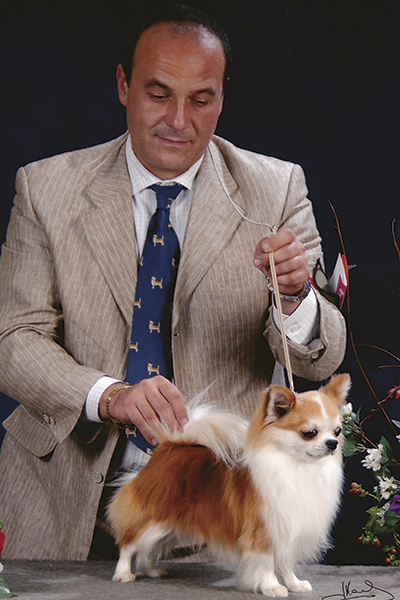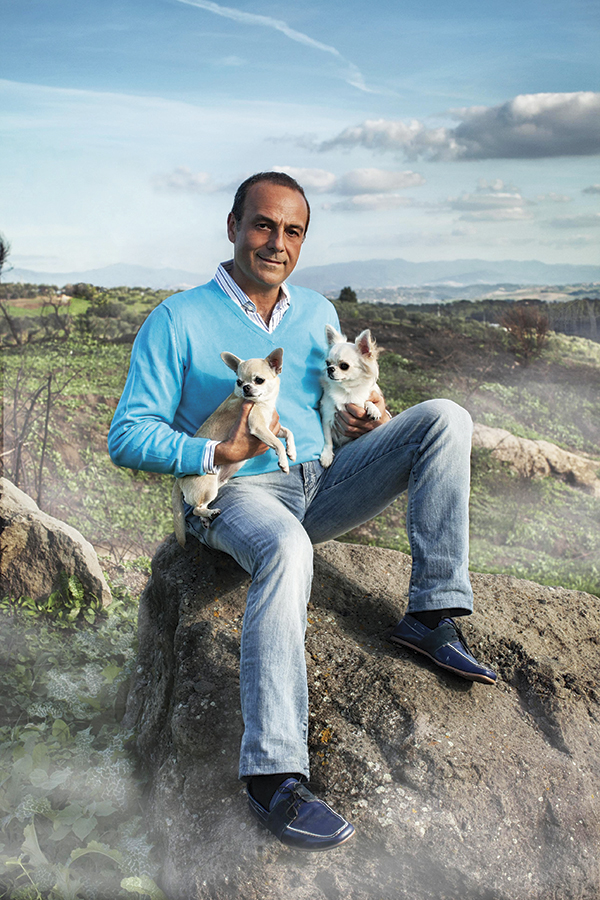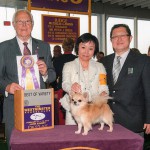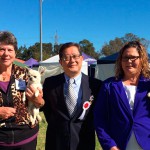Di San Gimignano Chihuahuas
Interview with Mr. Francesco Cochetti • Interviewed by J. Danilovic
Published in Best in Show Summer 2016
BIS: How long have you been breeding Chihuahuas? How and why have you decided to breed Chihuahuas?
F.C.: I had my first Chihuahua litter in 1996. It was by chance because my wife Tuula, at that time she was my girlfriend, moved to Italy in February of that year with 6 of her Misty Meadow’s Chihuahuas. One of her most beautiful females Misty Meadow’s Heaven Can Wait “Hilda” came into season. We hadn’t yet any of the males with us, as she was moving her dogs from her Finnish home little by little. She was in Finland during those days and I called her to say that Hilda had started her season. She suggested that I phone Marcella Martinotti (Dacharella’s Kennel) to ask her for the possibility to use her male, CH Dachida’s Abracadabra. I went to mate Hilda with him during the night. Tuula was so happy and decided that the future litter will be born under my kennel name. From that litter I bred a World Winner, Multi CH Stardust Di San Gimignano. So you see, Chihuahuas came into my life because of my wife. I was born with Poodles.

BIS: What makes Chihuahuas so special and different than other dogs? Why would you tell people to get a Chihuahua?
F.C.: Before I ever had the opportunity to be in close contact with the breed, I could have never imagined what a sensitive breed the Chihuahua is. Since I was a child, I have lived with dogs of many different breeds but I have never noticed this particular quality in any of them. It’s a companion dog but at the same time it’s a very independent breed. Chihuahuas are like potato chips, when you get one you want more and more.
BIS: What more can you tell us about the beginning?
F.C.: As I have already mentioned Chihuahuas came into my life because of my wife, so I was older. I was born into a dog family, and my parents were breeding poodles. At that time I could have never imagined it being at all possible to fall in love with another breed. My foundation dogs were poodles from Tiopepi Kennel in England. Among the first was a medium size black female called Tiopepi Jamila. My foundation Chihuahua was “Hilda”, the female I have mentioned above, bred by Tuula. Later, she gave me a few other females to show and I bred litters with them.
BIS: How many dogs do you have? Are they all living with you or do you also practice co-ownerships?
F.C.: I have, or better we have, as I breed together with my wife, 30-35 Chihuahuas, 2 Pointers and 3 Jack Russell Terriers. We do not practice co-ownership but sometimes we lease young dogs to people we trust and we know personally.
BIS: Do you co-work with other kennels? If so, can you please tell us little bit more about kennel collaborations?
F.C.: We are working as breeders, for the good of the breed. We have been co-oporating with breeders in England for a long time and we never had any problems. We have never been jealous of others in the dog world and when we see serious people perhaps even beginners, who want to do things properly we help them. I’m proud to say that we have helped establish the basis of many important kennels in Europe and in South America.
BIS: Are collaborations between kennels the key to successful breeding?
F.C.: Yes, absolutely! This is the key to success for every breeder. You need others and others need you. Jealousy can kill a breed and unfortunately there are some people too full of themselves. This can only lead to a short life in our dog world.
BIS: Did you have a mentor at the beginning? Whom do you admire the most in the breed and breeding in general?
F.C.: My parents were my mentors and I have to mention Tina Violi Gussoni as a mentor of my judging . She was an Italian all rounder and the president of the Italian Toy Dog Club. She had a deep knowledge about dogs and preparation. In chihuahuas, I must say I learned a lot from my wife.
BIS: What is the most important thing about being a breeder?
F.C.: Knowledge, a good eye, passion and humility. These ingredients are the key to success.
BIS: What makes one a good breeder?
F.C.: A good breeder is one who is able to consistently breed winners and the same type of dogs. Looking at the dogs of a good breeder you can recognise the origin.
BIS: Do you remember your first Champion? Do you know how many Champions you have had so far (your own dogs, and your bred dogs)?
F.C.: My first champion was a Poodle and it was Tiopepi Jamila. Together with Tuula, we have bred about 500 champions.
BIS: What are your personal favorite wins?
F.C.: World and European Winner titles. The UK champion is, for me a great achievement. Of course to win BIS is an amazing result, especially for a Chihuahua.
BIS: Are dogs shows important for breeding? What positive effects do they haveon breeding and when do they hurt good breeding ?
F.C.: I think for a breeder, a dog show is a must. It’s the right place to show the work that the breeder has done as well as being a place to compare the work with others. For beginners especially, it’s the place to meet other breeders and to have the possibility to start co-operation between breeders. To show dogs means to spend money and to invest in your work. A breeder can benefit from the opinion of a good judge, and check if he/she is working in the correct way. Thusshowing directly affects breeding . A good breeder should never use a dog with too many faults.
BIS: What do you think about flashy and showy dogs as oppose to the Standard balanced dogs?
F.C.: I think most of the judges are following the breed standards when they are judging. The breed standard is the only parameter available upon which the judge can base his evaluation in the ring. Flashy show dogs win sometimes but I believe that, in most cases these dogs also represent very the breeds well. If a dog is not a correct specimen of the breed and wins only because of showmanship and flashiness with the aid of social networks, then this will be immediately known and criticized.
BIS: Do you think show trends change the breed and in what way?
F.C.: Social networking sites almost certainly do influence certain show trends, as of course a dog who is winning constantly is advertised a lot, but probably one good breeder can change the breed. In my opinion, the breeder who has a great impact for many years can have that power. For the most part, a good breeder likes to preserve the breed which means that they will try to improve it and will not change the essential part of the breed.
BIS: Many people like to show under breed specialist judges. What is the most important thing to remember when judging a Chihuahua?
F.C.: The Chihuahua is a big dog in a small package. They should have nothing less than other breeds. Even if it is called a head breed, we can never forget soundness. I like to show under breed specialist judges, but sometimes specialists are focused on a particular thing. I find that good all rounder judges are often looking more at the whole picture.
BIS: Can you please tell us who are your personal breed specialist judges?
F.C.: I don’t like to write any one name, as I find it impolite, but I like to show under breed specialist judges from the UK where the breed is so well represented.
BIS: Can judges change the breed if they don`t understand the Standard correctly?
F.C.: I’m sure they cannot! The dog world is very small and the news travels fast!
BIS: What is the most important thing you would never compromise in your breeding program?
F.C.: Soundness and movement must be there. A Chihuahua with an excellent head and poor construction is a pet.
BIS: Do you think the breed changed and evolved in a good or bad way over the past years?
F.C.: It is evolving in a good way, but I have to say that we in the dog world have, at the moment some problems with bad fronts, part of a larger problem in movement. Unfortunately there is still too much focus on heads and breeders forget sound construction.
BIS: How many generations of your affix (kennel name) have you bred?
F.C.: Considering my wife bred our Misty Meadow’s chi’s, probably 8-10 generations have our kennel names. I can happily say we have our own bloodline.
BIS: What do you think is your biggest achievement as a breeder?
F.C.: We have bred 500 champions and achieved champion titles in almost all active dog world countries. This is an achievement to be proud of.
BIS: What dogs (male and female) do you think have left the biggest positive mark on the breed? And why? How did they improve the breed?
F.C.: Multi CH Misty Meadow’s Dressed To Dance (smooth) and Multi CH Misty Meadow’s Bart Simpson. They gave type and soundness and they are in the pedigrees of most of the winners.

BIS: What do you think about breeding to titles and using “popular” Champion studs?
F.C.: It means poor knowledge of the breed. Breeding to titles means one doesn’t care about the breed. Breeding good dogs is a different task and first of all we should breed according to the standard.
BIS: Do Chihuahuas have certain breed problems? Can you tell us little bit about breed problems in your opinion?
F.C.: The chihuahua is a healthy breed, however like other toy breeds, patella luxation can be a problem in the breed. Even if nowadays most of the breeders are checking for it and it is under control. Sometimes people are more emotional than informed about this and they don’t know that even from parents who are patella free they can get offsprings with patella problems.
Chihuahuas are not an easy breed to whelp. Even with natural whelping the structure of the head can make whelping not so easy.
BIS: What advice would you give to someone that is buying a Chihuahua for the first time?
F.C.: First of all, they have to know that it is not an easy breed in which you get results. Whelpings are quite difficult and there are other risks in the breed. Their short muzzles can give undershot bites and this is another risk you have. It’s the most sensitive breed and it is imperative to understand their personality or risk ruining them for ever. I have to say I consider the chihuahua is one of the most difficult breeds and the most satisfying because getting good results with them is a great reward for a breeder.



